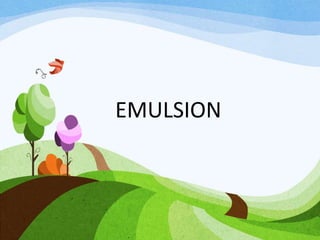This document defines and describes emulsions. An emulsion is an unstable mixture of two immiscible liquids stabilized by an emulsifying agent. Emulsions can be classified as simple (macro), multiple, or micro. Simple emulsions are oil-in-water or water-in-oil, while multiple emulsions contain both types simultaneously. Microemulsions are clear, thermodynamically stable mixtures containing oil, water, surfactant and sometimes cosurfactant. Emulsions require emulsifying agents, viscosity modifiers, preservatives and sometimes antioxidants for stability. Common emulsifying agents include surfactants, hydrocolloids, and finely divided solids. Instability can occur via flocc


















































